Live updates: 2024 presidential election | CNN Politics
Vice President Kamala Harris and former President Donald Trump each need at least 270 electoral votes to win the presidency. Follow here for 2024 presidential election updates, results, analysis and more.
1. Live updates: 2024 presidential election | CNN Politics
• Americans are heading to the polls to vote for their next president. Vice President Kamala Harris and former President Donald Trump each need at least 270 electoral votes to win. The battleground states of Arizona, Georgia, Michigan, Nevada, North Carolina, Pennsylvania and Wisconsin are expected to be pivotal to the path to victory.
• Harris and Trump tied with three votes each in the tiny New Hampshire community of Dixville Notch, which opened and closed its poll just after midnight ET in a decades-old tradition. Here’s an hour-by-hour guide of what to expect when state polls begin closing at 7 p.m. ET.
• The candidates held their final campaign events in battleground states last night. Harris ended her 107-day campaign in Pennsylvania, while Trump spoke in Michigan — where he has ended three of his presidential campaigns.
• Visit CNN’s voter handbook to see how to vote in your area and read up on the 2024 candidates and their proposals.
Election Day is here. Millions of Americans have already voted early, but if you plan on voting in person today, it is important to know that the time polls open vary by location, sometimes within a county or municipality in a state.
Here’s a look at some of the earliest poll opening times (all times in ET):
6 a.m.
6:30 a.m
7 a.m.
8 a.m.
For more information on how to vote in your area, see CNN’s voter handbook.
Link Copied!
 Stickers sit on a table in Little Chute, Wisconsin on November 1.
Stickers sit on a table in Little Chute, Wisconsin on November 1.
Scott Olson/Getty Images
It’s Tuesday, November 5, and polls are beginning to open across the country.
Last night, the presidential candidates made their final late-night pitches to potential voters in battleground states.
In former President Donald Trump’s final rally, he argued that his real opponent was not Vice President Kamala Harris but an “evil Democrat system.” Harris, meanwhile, did not mention Trump, but ended her 107-day campaign with a pledge to “turn the page on a decade of politics that has been driven by fear and division.”
Here’s what else to know this morning:
Link Copied!
When Americans cast their votes today, they are not directly electing the presidential candidates themselves. Voters are casting ballots for competing slates of “electors” who will in turn cast the actual votes for president and vice president on December 17. Collectively, the electors from all 50 states and the District of Columbia are referred to the “Electoral College.”
The presidential candidate who wins the majority of the popular vote on election night does not necessarily win the White House. In order to win the presidency, a candidate must win a majority of votes in the Electoral College.
Here’s how the Electoral College works:
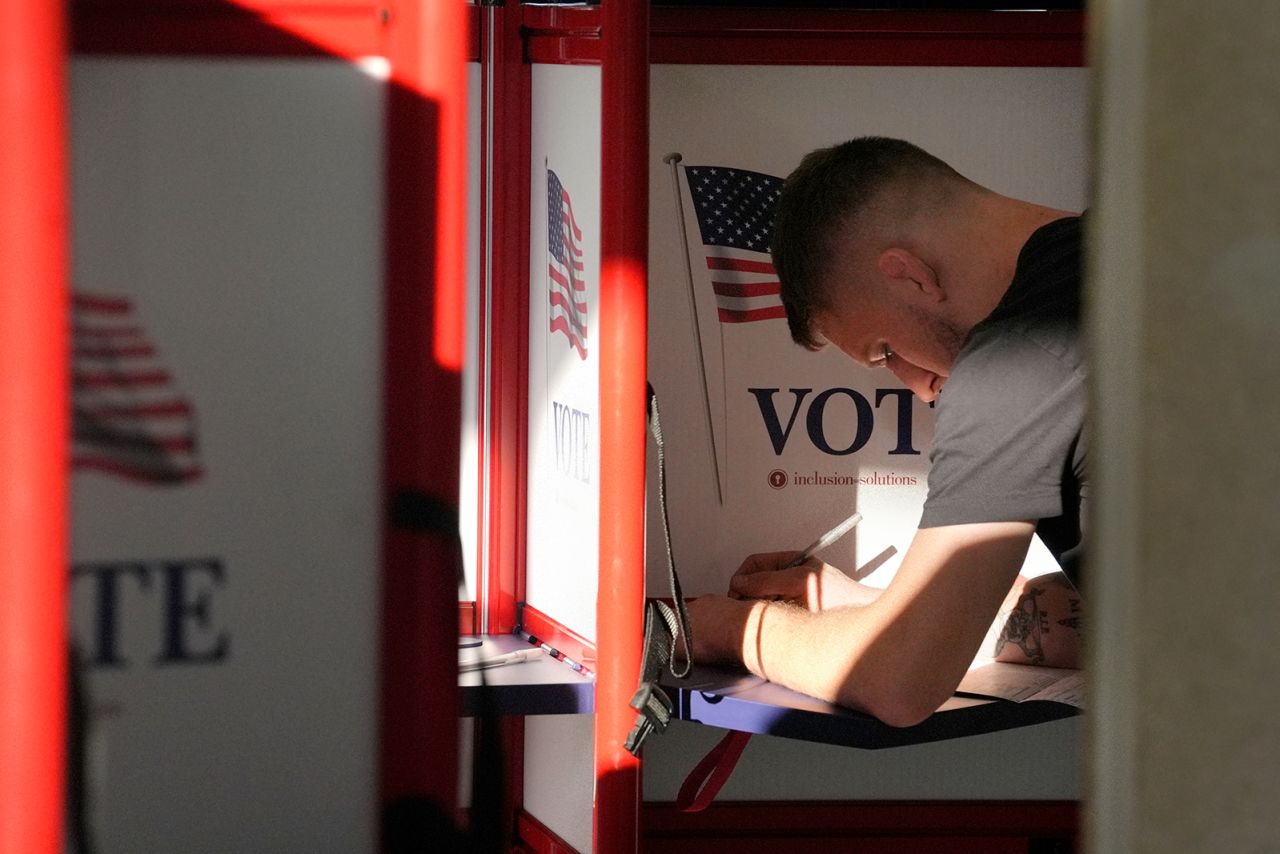 A voter fills out their their ballot during early voting in the general election in Fall River, Massachusetts, on November 1.
A voter fills out their their ballot during early voting in the general election in Fall River, Massachusetts, on November 1.
Steven Senne/AP
Both Kamala Harris and Donald Trump targeted Gen-Z voters as they campaigned ahead of the election, many of whom will be voting for the first time today.
Columbia University’s Columbia Magazine found that Gen Z make up more than 40 million voters, including eight million new voters.
And social media’s influence on these voters cannot be underestimated, according to Aidan Kohn-Murphy, founder of advocacy group Gen-Z for Change. He told CNN that TikTok has helped inform many young people about the presidential candidates and their campaigns.
Key issues for younger voters are “climate, reproductive justice, gun violence and Biden’s incredibly unpopular support for the Israeli government,” Kohn-Murphy said.
He said that young people shared information on TikTok in a “peer-to-peer model, that really leads people to support candidates more.”
He also noted that many first-time voters did not have previous political scandals — such as former President Donald Trump’s “Access Hollywood” tape — on their radar, but social media had enabled them to learn more about the candidates.
“We were somewhere between fifth grade and seventh grade when the access Hollywood tapes came out. We have gotten numb to Trump’s horrible words and actions, however these are things we have not heard and I think that TikTok has provided a way to kind of remind and shock young people.”
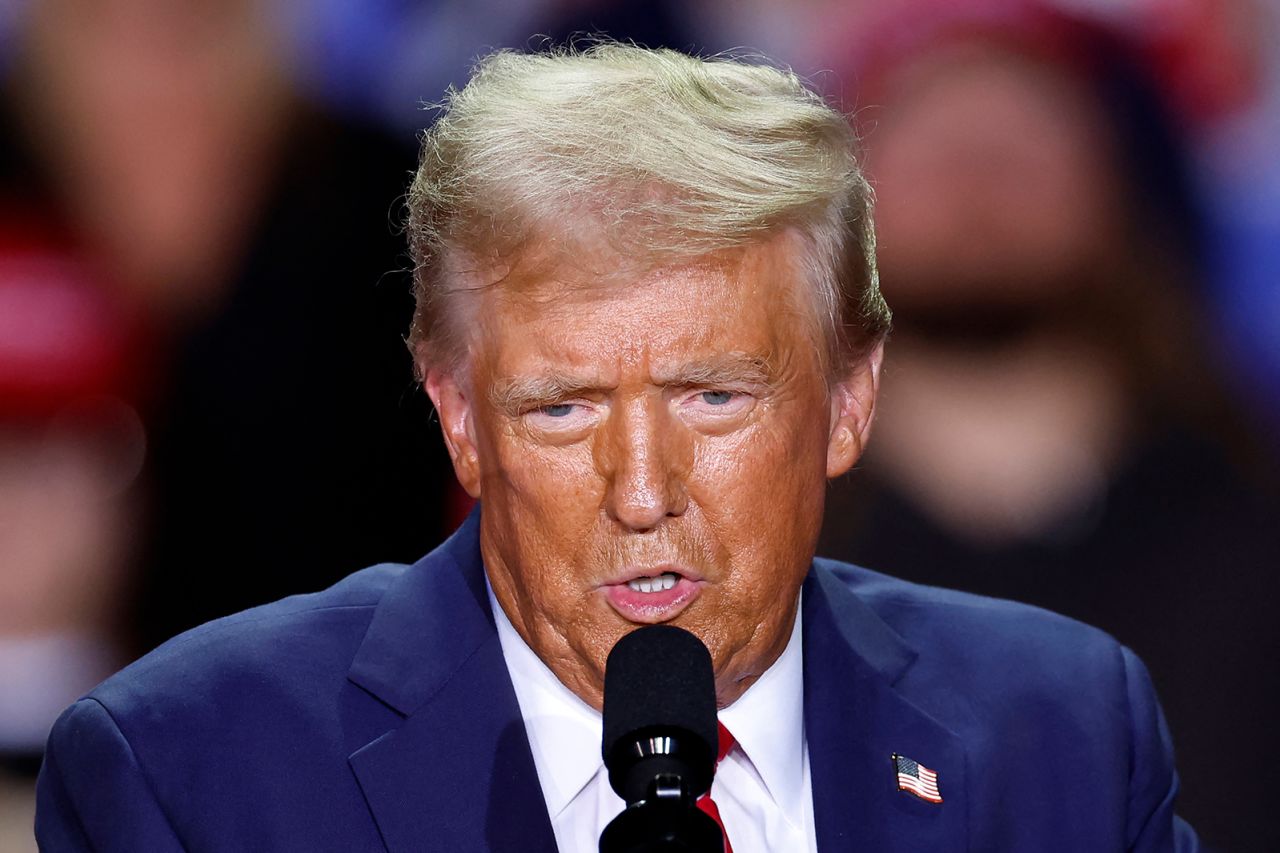 Donald Trump speaks during a campaign rally at Van Andel Arena in Grand Rapids, Michigan on November 5.
Donald Trump speaks during a campaign rally at Van Andel Arena in Grand Rapids, Michigan on November 5.
Kamil Krzaczynski/AFP/Getty Images
Former President Donald Trump argued during the final rally of his campaign that his real opponent this election was not Vice President Kamala Harris but instead “an evil Democrat system.”
“We will defeat the corrupt system in Washington. Because I’m not running against Kamala, I’m running against an evil Democrat system. These are evil people,” Trump said during his rally in Grand Rapids, Michigan, that started well after midnight.
“The silent majority is back and tomorrow you need to get out and vote,” Trump said.
“This has been an incredible journey. And it’s very sad in a way, because, you know, we’ve done all these, and this is the last one, but here’s the good news, all we were doing is putting ourselves in a position to win, which we can do tomorrow very easily if we show up,” he added.
Link Copied!
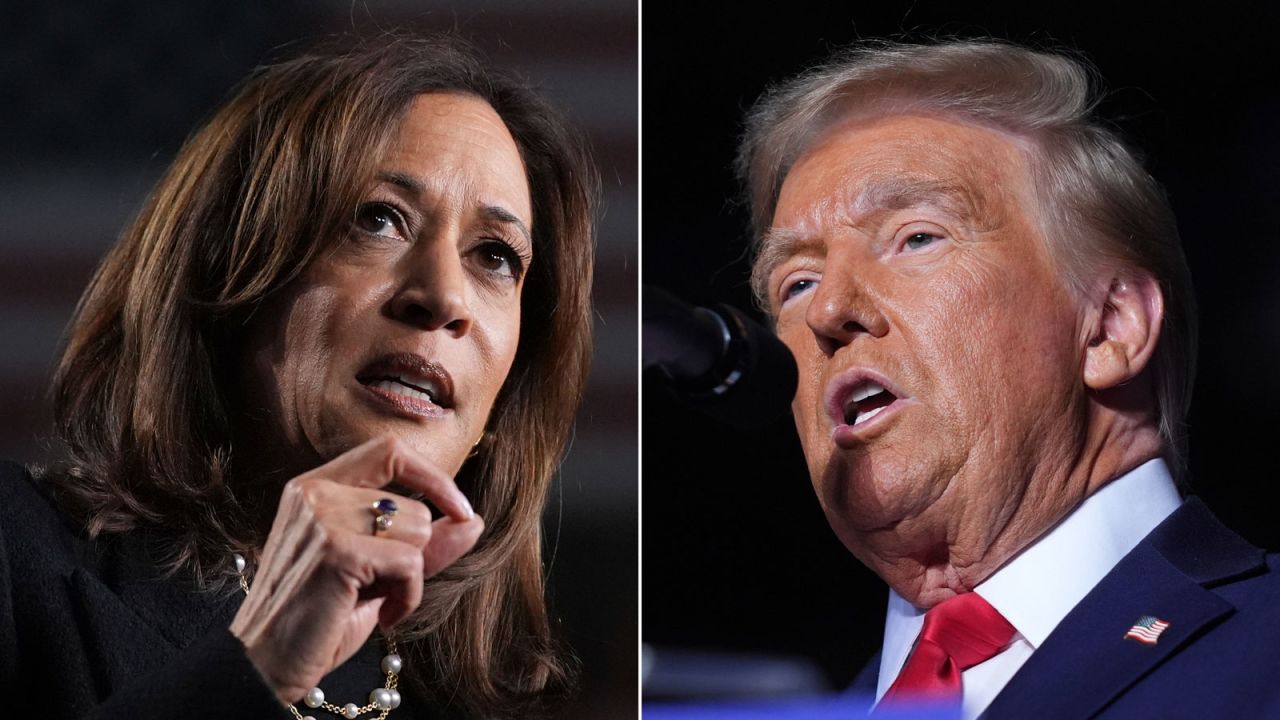 Vice President Kamala Harris and former President Donald Trump.
Vice President Kamala Harris and former President Donald Trump.
AP
It’s decision day for voters in America’s battle for the White House and control of Congress — even if the results could take days or weeks to sort through.
Vice President Kamala Harris and former President Donald Trump are hoping to win over seven swing states: Michigan, Pennsylvania and Wisconsin, the three Great Lakes states that make up the “blue wall” that Trump cracked in 2016 but President Joe Biden carried in 2020, and Arizona, Georgia, Nevada and North Carolina, the four Sun Belt battlegrounds.
While the election of either candidate would be historic, there’s much more being decided Tuesday, including five states — Arizona, Florida, Missouri, Nebraska and South Dakota — voting on whether to turn back abortion bans with constitutional amendments.
Republicans hope to take advantage of a favorable Senate map, with Democrats defending seats in the red-leaning states of Montana, Ohio and West Virginia. The party’s hopes of holding onto its narrow House majority winds from the coast of Maine through New York’s Hudson Valley, the rolling hills of Virginia’s Piedmont, a “blue dot” in Nebraska and into California’s Orange County, where the political ebbs and flows of the Trump era have been on vivid display.
The initial results in the hours after polls close might not be determinative. States decide their own election procedures, and the order in which states count early, mail-in and Election Day votes varies across the map — as does how quickly certain cities, counties and regions report their results.
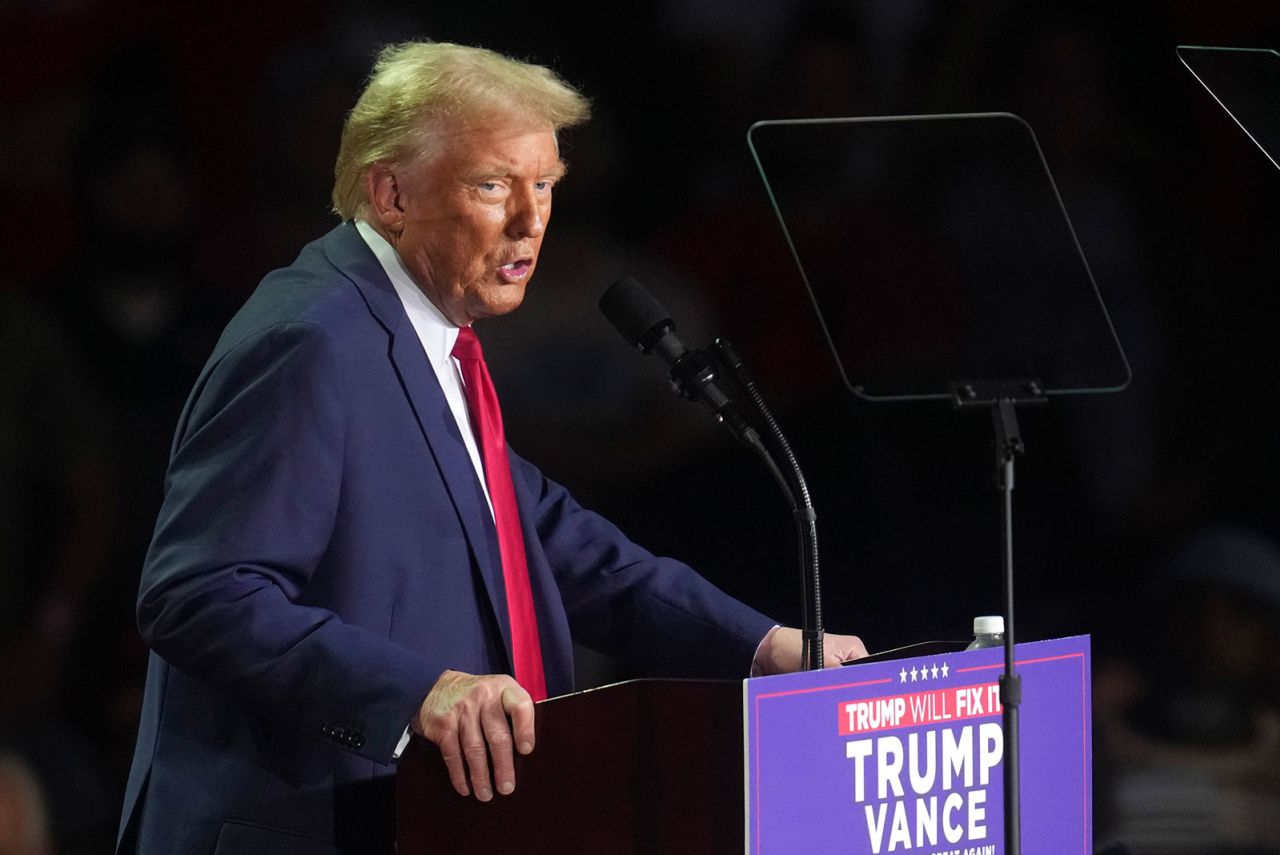 Trump speaks at a campaign rally in Grand Rapids, Michigan on Tuesday.
Trump speaks at a campaign rally in Grand Rapids, Michigan on Tuesday.
Paul Sancya/AP
Former President Donald Trump has ended his final campaign rally after speaking for nearly two hours in Grand Rapids, Michigan.
He repeated many of his campaign promises, such as vowing to impose hefty tariffs and to crack down on illegal immigration.
At one point he also brought several of his children and their spouses to the stage, who delivered brief remarks, including Tiffany, Eric and Donald Jr.
His marathon address ends a long campaign trail — with Trump saying he had attended more than 900 rallies this year.
 Minnesota Gov. Tim Walz participates in an interview with Stephen Colbert.
Minnesota Gov. Tim Walz participates in an interview with Stephen Colbert.
The Late Show with Stephen Colbert/CBS
Minnesota Gov. Tim Walz said he’s disappointed the race between Vice President Kamala Harris and former President Donald Trump is so closely contested.
In an interview on CBS’ “The Late Show with Stephen Colbert” taped in Bucks County, Pennsylvania last Thursday, Walz laid out the contrast between the two candidates to show that the difference is “stark.”
He said of the election being so closely contested: “It disappoints me, I think, because I think that the choice is so stark, but it’s not surprising.”
“The country’s really divided. There’s been a group of people out there who figured that out, and I think they’ve done a wonderful job of making people think it doesn’t matter, everybody’s the same,” Walz said.
Walz then laid out how he saw the differences between Harris and Trump, particularly noting insults directed toward Puerto Rico made by a speaker at a Trump rally in October.
“In this case, you’ve got the Constitution versus not the Constitution. You’ve got reproductive rights versus I don’t care if you like it or not. I’ll tell you what to do, from Donald Trump in closing with insulting people. I know we’re sitting in Pennsylvania, there’s — there’s 500,000 Puerto Ricans here, and Puerto Ricans, as all Americans, are very proud of where they come from,” he said.
In the past, Walz has expressed some disbelief at the competitiveness of the presidential election. He has regularly mused at private fundraisers and campaign stops that “I’ll go to my grave not understanding” how the election is so close.
 Kari Lake speaks at a campaign rally, Monday, November 4, in Prescott, Arizona.
Kari Lake speaks at a campaign rally, Monday, November 4, in Prescott, Arizona.
Julio Cortez/AP
Arizona Republican Senate candidate Kari Lake has held her final campaign rally, telling supporters that on Tuesday they have “a chance to change the trajectory of this country and save this Republic.”
Campaigning on the steps of the Yavapai County Courthouse in Prescott, Arizona on Monday — where US Sen. Barry Goldwater of Arizona launched his presidential campaign — Lake, a former TV newscaster up against Democratic Rep. Ruben Gallego in a key Senate race, argued that the “Make America Great Again” movement “is not dead,” and claimed that a “silent majority” will back her and former President Donald Trump tomorrow.
Lake and Gallego, a Marine veteran who represents Arizona’s 3rd congressional district, are vying for the pivotal Senate seat held by independent Sen. Kyrsten Sinema.
Lake, who did not concede her 2022 election loss and promoted Trump’s false theories about the 2020 election, said she believes in “fair and honest elections” and argued “I really believe that our Founding Fathers never envisioned we’d have elections that are run so horribly.”
“That’s why they never put in term limits because they figured we’d be able to vote the people that we didn’t respect out of office. And unfortunately, we haven’t been able to do that. And we’re going to change that after January. But the only way to change that is to show up in such a massive movement that we have their heads spinning,” she said, pointing to the media.
She also thanked GOP congressional candidate Abe Hamadeh and said: “When they did to us what they did to us in 2022, and everyone else ran and hid, guess who stood with me and said, damn it, we’re going to fight — Abe Hamadeh.”
She argued the election is not “Republican-Democrat anymore” but “Americanism versus communism.”
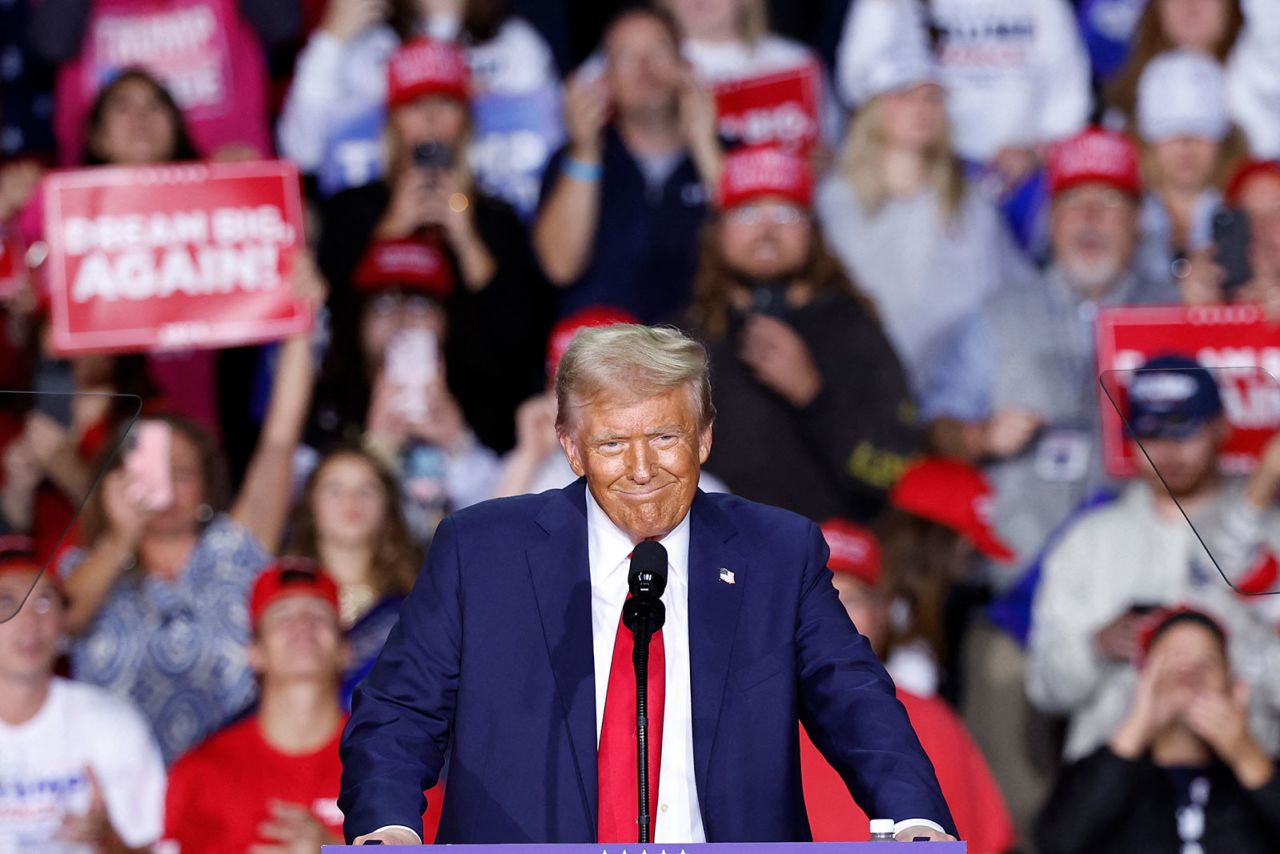 Former President Donald Trump speaks during a campaign rally in Grand Rapids, Michigan on Tuesday, November 5.
Former President Donald Trump speaks during a campaign rally in Grand Rapids, Michigan on Tuesday, November 5.
Kamil Krzaczynski/AFP/Getty Images
Former President Donald Trump slammed US Rep. Nancy Pelosi during his final rally in Grand Rapids, Michigan, verging on using a profanity to describe the former House Speaker.
“She’s a crooked person, she’s a bad person. Evil, she’s an evil, sick, crazy bi— It starts with a ‘B’but I won’t say it. I wanna say it,” Trump said to cheers from the crowd.
“I don’t use much (foul language), you know, every once in a while, and it’s never a real bad word, it’s never bad … But it is a little better when you use foul language. These are bad people,” he said.
Trump constantly rails against Pelosi and recently called the California Democrat “an enemy from within.”
Throughout the end of his campaign trail, Trump’s message has gotten increasingly dark and often offensive. At an event in North Carolina last week, Trump chuckled approvingly at an audience member’s suggestion that Vice President Kamala Harris worked as a sex worker.
Link Copied!
Vice President Kamala Harris will spend Election Day in Washington, DC and participate in radio interviews, according to her office.
Link Copied!
Former President Donald Trump has taken the stage in Grand Rapids, Michigan — giving the city a special shout-out for being the location of his final rallies in past presidential campaigns.
“I want to say a very special hello to Grand Rapids, it’s been a special place, remember 2016?” he said to a cheering crowd that chanted his name.
Trump previously also finished his campaign trail in the city in 2016 and 2020.
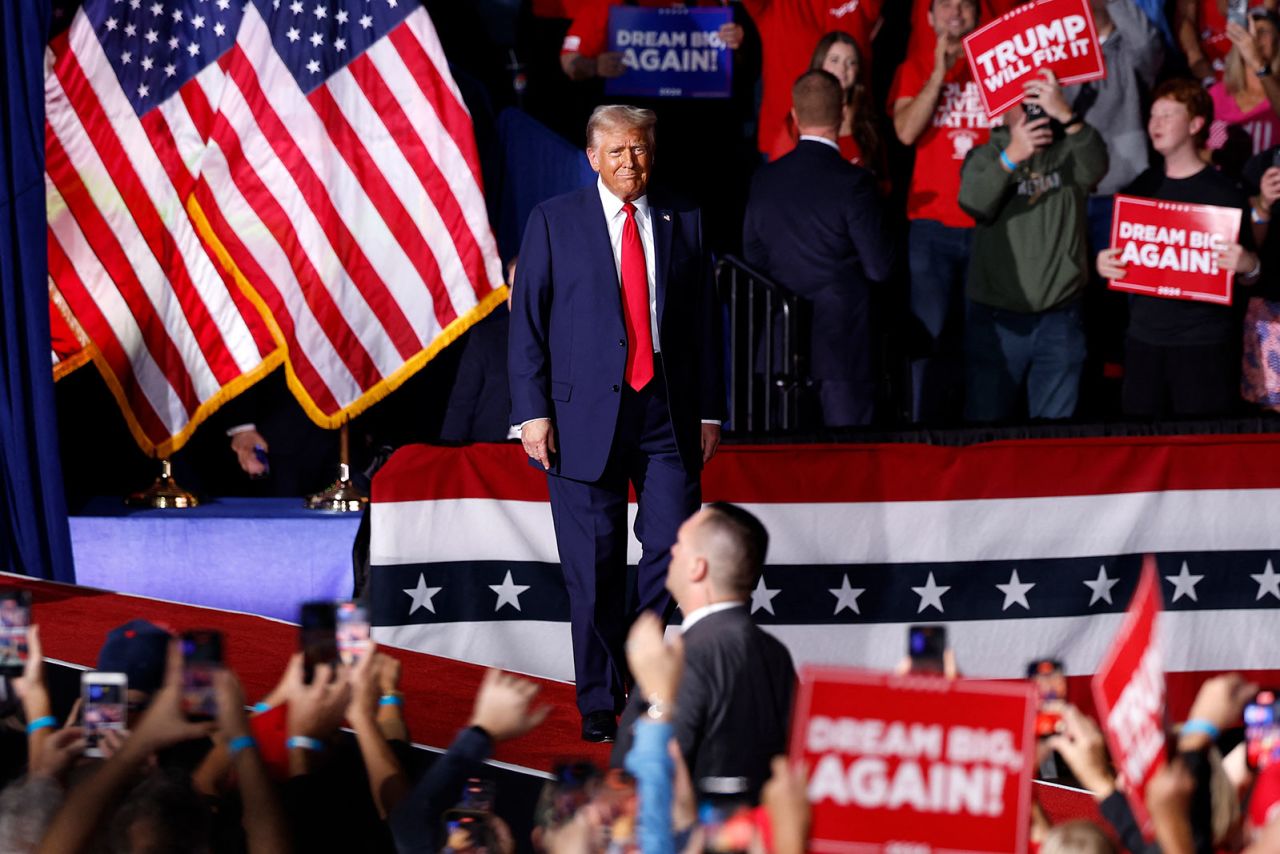 Former President Donald Trump walks on stage for his final campaign rally in Grand Rapids, Michigan on Monday, November 4.
Former President Donald Trump walks on stage for his final campaign rally in Grand Rapids, Michigan on Monday, November 4.
Kamil Krzaczynski/AFP/Getty Images
Former President Donald Trump is speaking at his final rally in Grand Rapids, Michigan, where he ended both his 2016 and 2020 campaigns. His remarks were originally slated for 10:30 p.m. ET.
Grand Rapids is a Western Michigan city in Kent County, which swung from Trump in 2016 to Joe Biden in 2020.
Video Ad Feedback See the moment the first results are announced in the 2024 presidential race 00:52 - Source: CNN
Vice President Kamala Harris and former President Donald Trump have tied with three votes each in the tiny New Hampshire township of Dixville Notch, kicking off Election Day in one of the first places in the country to report its presidential preference.
Four Republicans and two undeclared voters participated.
The unincorporated township, located along the US-Canada border in New Hampshire’s northern tip, opened and closed its poll just after midnight ET in a tradition that dates back to 1960.

Hannah McKay/Reutes
Speaking at her final campaign rally in Philadelphia before Election Day on Monday night, Vice President Kamala Harris said her team was “optimistic and excited” — but urged voters to make their voices heard, saying Pennsylvania could “decide the outcome” of the election.
“The race ain’t over yet, and we must finish strong. This could be one of the closest races in history. Every single vote matters,” she said.
“With only a few hours left, we still have work to do, and as you’ve heard me say before, we like hard work,” she added.
At points, the crowd broke into cheers of “We will win” and “We’re not going back.”
Harris reiterated several campaign promises, such as lowering the cost of living, housing, childcare, elderly home care, and taxes for workers and small businesses. She also vowed to pass a bill to restore reproductive freedoms after the rolling back of Roe v. Wade.
She sought to contrast herself with Donald Trump by using several familiar refrains — such as promising a seat at the table to those who disagree with her, compared to the former president’s often vehement rhetoric against his political opponents.
“We started this campaign 107 days ago,” she said. “From the beginning, ours has not been a fight against something, it has been a fight for something. A fight for a future with freedom, with opportunity, and with dignity for all Americans.”
“Tonight, we finish as we started — with optimism, with energy, with joy, knowing that we the people have the power to shape our future, and that we can confront any challenge we face when we do it together.”
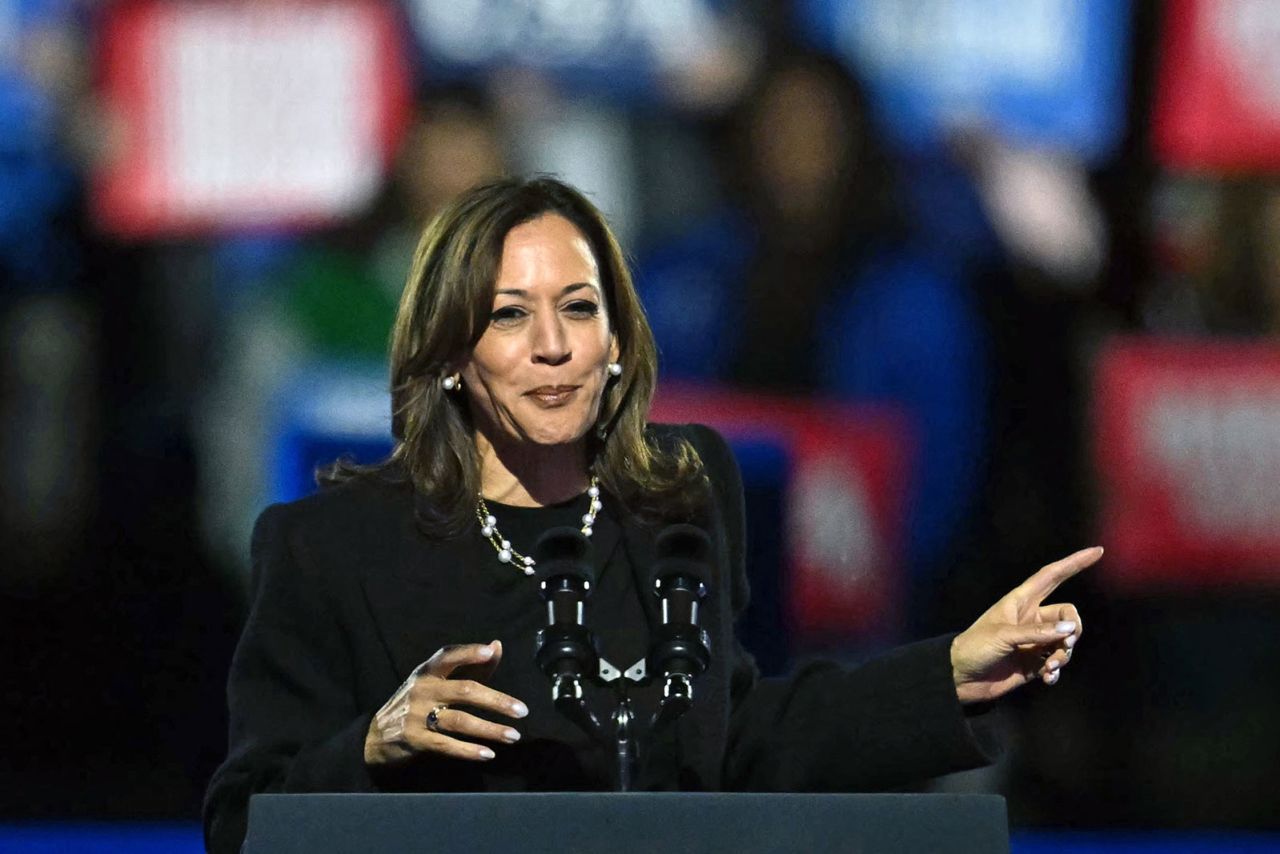 Vice President Kamala Harris speaks during a campaign rally in Philadelphia, Pennsylvania on Monday,November 4.
Vice President Kamala Harris speaks during a campaign rally in Philadelphia, Pennsylvania on Monday,November 4.
Angela Weiss/AFP/Getty Images
Vice President Kamala Harris is speaking at a rally in Philadelphia, her final stop in front of voters before Election Day.
Harris has made the key battleground of Pennsylvania her priority on Monday with several stops across the state culminating in her final one in the state’s largest city.
She was joined by Oprah Winfrey and Lady Gaga, among other celebrities, musicians and elected officials at the famous “Rocky Steps” at the Philadelphia Museum of the Arts.
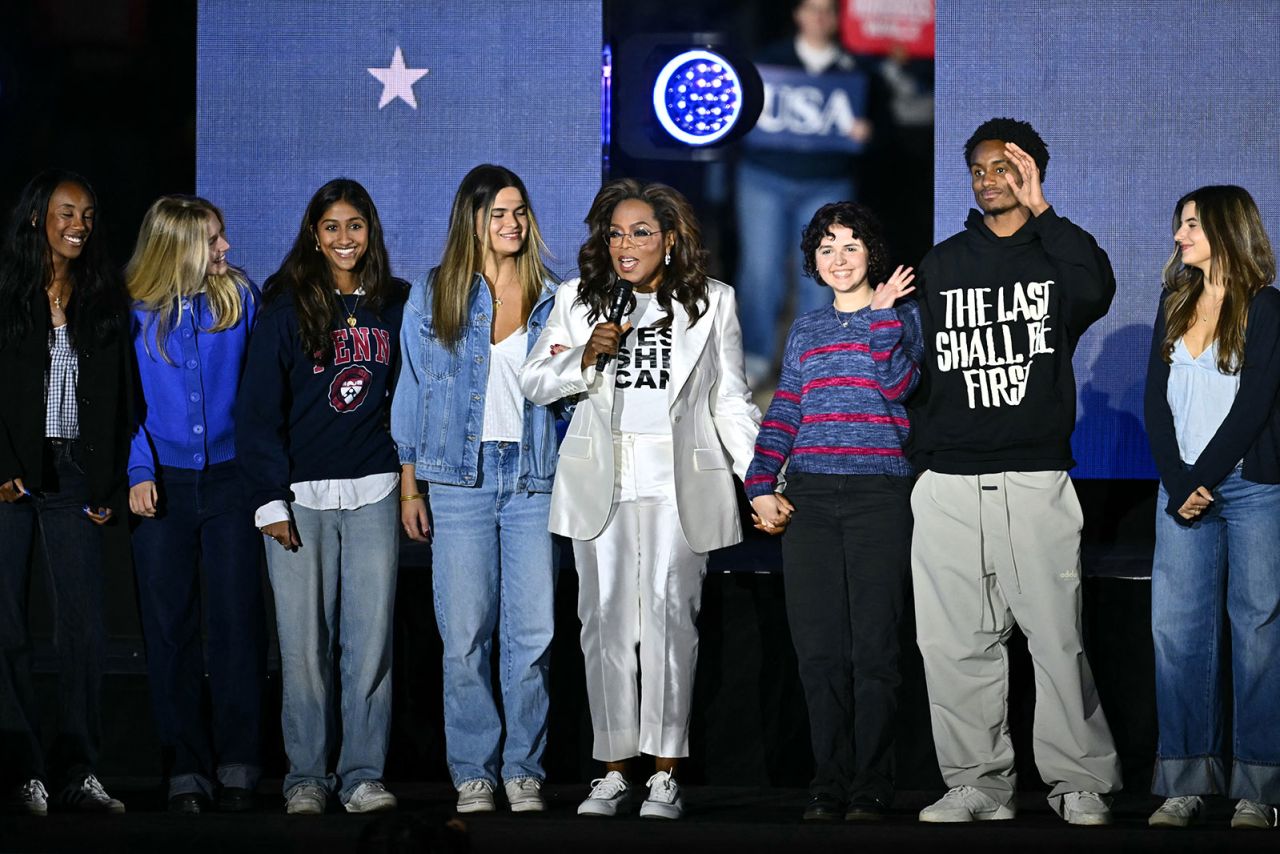 US television producer Oprah Winfrey arrives on stage with 10 first-time Philadelphia voters during a rally for Kamala Harris in Philadelphia, Pennsylvania, on November 4, 2024.
US television producer Oprah Winfrey arrives on stage with 10 first-time Philadelphia voters during a rally for Kamala Harris in Philadelphia, Pennsylvania, on November 4, 2024.
Angela Weiss/AFP/Getty Images
Oprah Winfrey took the stage at Kamala Harris’ final rally in Philadelphia on Monday night alongside 10 young people – all first time voters.
“The policies that Kamala Harris has proposed for women’s reproductive rights and education equality are what led me to cast my ballot for her,” one voter told Winfrey.
Another first-time voter said it was especially significant for him as an African American to “exercise my right to vote, which my ancestors fought so hard for.”
“We don’t get to sit this one out,” Oprah said.
“If we don’t show up tomorrow, it is entirely possible that we will not have the opportunity to ever cast a ballot again.”
“We are voting for healing over hate,” she said.
“What you can do for your country, what you can do for democracy here, and what you can do for the spirit of John Lewis and all the others who dared to walk across that bridge in Selma and fight for justice for us all … What you can do for every pregnant young woman who has died bc she was not eligible to receive the emergency medical care she desperately needed bc of an abortion ban, what you can do for everyone and everything you cherish — is vote.”
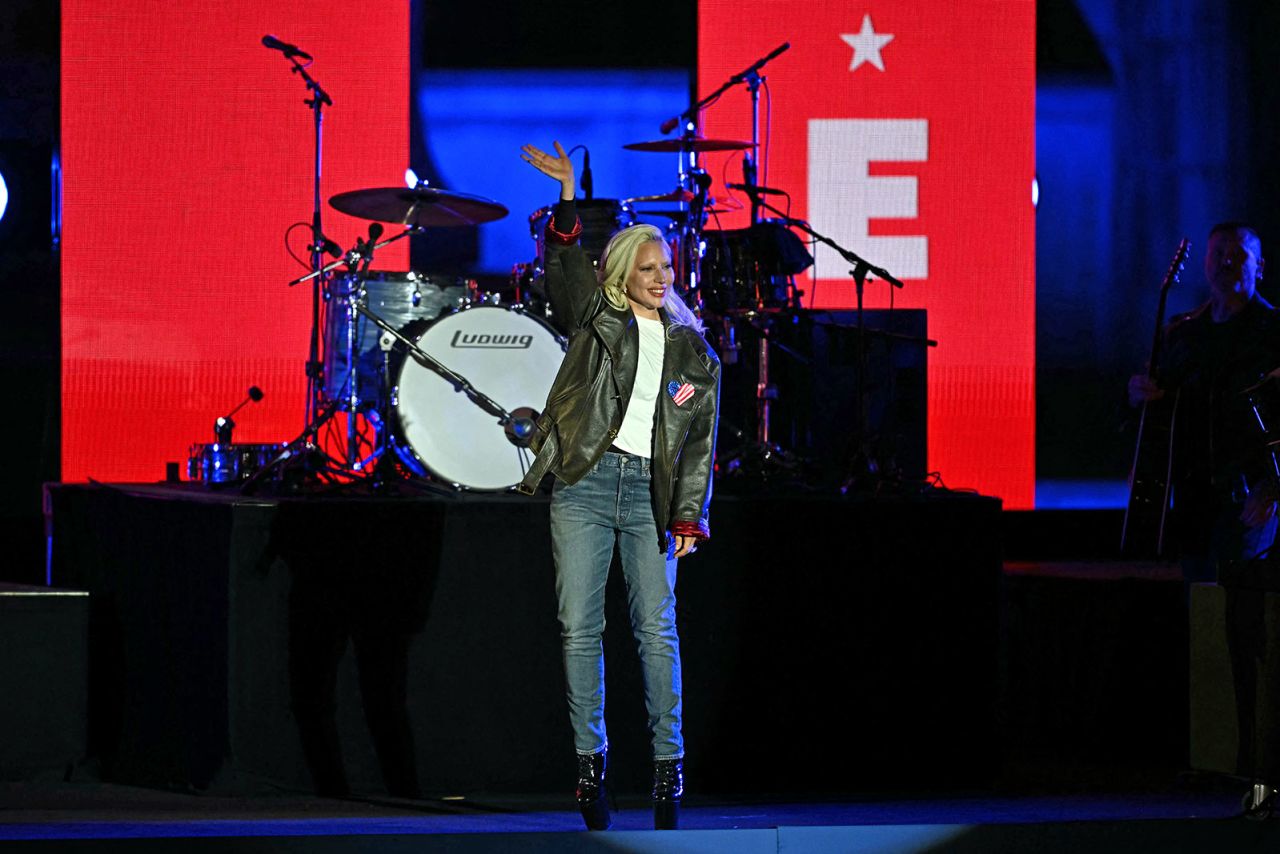 Lady Gaga waves before performing during a campaign rally for Vice President Kamala Harris in Philadelphia, Pennsylvania on Monday, November 4. (
Lady Gaga waves before performing during a campaign rally for Vice President Kamala Harris in Philadelphia, Pennsylvania on Monday, November 4. (
Angela Weiss/AFP/Getty Images
Musical superstar Lady Gaga appeared at Vice President Kamala Harris’ final rally in Philadelphia, performing a rendition of “God Bless America.”
“For more than half of this country’s life, women didn’t have a voice. Yet we raised children, we held our families together, we supported men as they made the decisions,” she said in brief remarks after her performance. “But tomorrow, women will be a part of making this decision.”
Oprah Winfrey is also expected to make an appearance tonight, before Harris delivers remarks.
Link Copied!
Minnesota Gov. Tim Walz focused heavily on access to abortion and reproductive health care, driving home a core message of Vice President Kamala Harris’ campaign in Detroit, Michigan on Monday.
In his remarks at Hart Plaza overlooking the Detroit River, Walz reiterated his attacks on former president Donald Trump, who claimed to be the “protector” of women and said he would look after women “whether they like it or not” at a campaign rally in Wisconsin last week.
He also made a direct pitch to male voters on abortion, asking them to consider the implications of abortion restrictions on the women in their lives.
“Let me speak to the guys in the crowd tonight. I want you to think about the women in your life that you love. Their lives are at stake in this election. Donald Trump appointed those Supreme Court justices who repealed Roe versus Wade, and he brags about it. He is glad that those women you’re thinking about and you love have fewer rights than their mothers and their grandmothers,” he said.
“We’re seeing women turned away from emergency rooms, miscarrying in parking lots, whether they like it or not. Survivors of rape being forced to carry those pregnancies to term, whether they like it or not. Fertility clinics turning couples away at the door, whether they like it or not,” he said.
“Now, tomorrow, women all across America of every age, both parties, are going to send a loud and clear message to Donald Trump, whether he likes it or not.”

Quinn Glabicki/Reuters
Her message has been consistent, but Kamala Harris has in the closing days of the presidential race dropped two notable words from her stump speech: Donald Trump.
The former president’s name was again absent from the vice president’s speech on Monday night in Pittsburgh, where she again promised voters a clean break from the discord of the Trump era in American politics. It was a notable switch in rhetoric for the vice president, who had mentioned Trump’s name so often in previous versions of her stump speech that the Republican’s campaign had put together a video compilation of Harris saying “Donald Trump” that he often played at rallies.
“We have an opportunity in this election to finally turn the page on a decade of politics driven by fear and division. We are done with that,” Harris said. “We’re done. We’re exhausted with it.”
That promise has been threaded through her campaign, usually implied but increasingly delivered in explicit terms.
“It can be easy to forget a simple truth,” Harris said in Washington. “It doesn’t have to be this way.”
The way it is, she said in Pittsburgh, is not so good.
“So much about these last several years has been about trying to make people point their fingers at each other,” Harris said, “to have Americans point their fingers at each other, to try and make people feel alone or feel small.”
Elon Musk held a digital version of the town-hall-style rallies he has hosted on behalf of former President Donald Trump. But the event on X ended just a few minutes after it started on Monday night, when Musk encountered technical difficulties.
The event began streaming more than 20 minutes after its scheduled 8 p.m. ET start time. When the billionaire X owner joined, he promoted a podcast interview he did with Joe Rogan and offered to take questions. An operator then attempted to take questions from four listeners who apparently had been on hold, but the line went silent when he called on them.
The operator asked Musk if he believes “we will win” on Tuesday — presumably referring to Trump, whom Musk has supported to the tune of tens of millions of dollars.
“Well, I think if people vote tomorrow, we’re definitely going to win,” he said.
Musk then called off the event, saying: “let’s cancel this, since we seem to be having some technical issues.” Musk promised to start a regular livestream spaces event on X. The X Spaces event Musk started immediately following the town hall, lasted one minute and appeared to have no audio.
Minutes later, Musk said he would not restart his Q&A and encouraged followers to listen to his Rogan interview instead, during which the podcaster endorsed Trump.
The Monday town hall is just the latest election-related event that Musk attempted to host on X that was plagued by technical difficulties.
An August interview between Musk and Trump that was streamed on X was delayed by more than 40 minutes because of glitches. Musk blamed the issue on a cyberattack, but some experts speculated it was simply caused by too many users trying to listen. A similar event last year to kick off Florida Gov. Ron DeSantis’ presidential campaign was also delayed by 25 minutes and marred by technical difficulties.

Carlos Osorio/Reuters
There are thought to be seven states that could conceivably be won by either candidate. As a result, the campaigns have focused their energy in these areas. They can be broken up into two general categories:
3 Midwestern battlegrounds, aka “the blue wall” – These are the manufacturing and union-heavy states of Pennsylvania, Michigan and Wisconsin. They used to be more reliably Democratic but have shifted in recent years as their populations have changed and as former President Donald Trump has appealed to White voters without a college degree.
When Trump won the White House in 2016, he won all three. When President Joe Biden won in 2020, he won all three. If Vice President Kamala Harris wins all three this year, she will likely have the electoral votes to be president. But polls suggest close races in all three. Turnout will be key, which for Harris means appealing to suburban women and Black voters. All three states have urban centers.
The blue wall states usually vote the same way. The last time they did not all go to the same candidate was in 1988 – notably also a year when California was red and West Virginia was blue. In those eight elections since 1988, the only time the blue wall states went to a Republican was in 2016, when they were won by Trump.
4 Sun Belt battlegrounds – These states with growing populations include Arizona and Nevada in the West and North Carolina and Georgia in the East. Arizona, Georgia and North Carolina used to be more reliably Republican. Trump won North Carolina twice, but the margins were close in 2020. The last Democrat to win there was Barack Obama in 2008. Biden was the first Democrat to win Georgia since Bill Clinton in 1992 and Arizona since Clinton in 1996.
 Former President Donald Trump and Vice President Kamala Harris.
Former President Donald Trump and Vice President Kamala Harris.
Getty Images
Ahead of election night, read up on the 2024 candidates on the Democratic and Republican tickets vying to win the White House.
Vice President Kamala Harris is the Democratic candidate for president. The daughter of immigrants from India and Jamaica, Harris grew up in Oakland and spent much of her political career in California’s Bay Area.
She was first elected as the San Francisco district attorney in 2004, before later serving as the attorney general of California. After that, Harris was elected to the Senate before being picked to be President Joe Biden’s running mate in the 2020 election.
She announced her own candidacy for the Democratic nomination for president after Biden withdrew from the ticket and endorsed her on July 21. Harris is the first Black woman and first Asian American to lead the ticket of a major political party.
Minnesota Gov. Tim Walz is Harris’ running mate. Before being elected to Congress to represent the state’s 1st Congressional District in 2007, Walz was a high school geography teacher and an assistant football coach. He also served in the Army National Guard. Walz has been serving as Minnesota governor since 2019.
Former President Donald Trump is the Republican candidate for president, aiming to become only the second commander in chief to win two nonconsecutive terms.
Trump, who was born in New York, graduated from the University of Pennsylvania with a bachelor’s degree in economics. Before launching his successful 2016 presidential bid, Trump was a real estate developer, businessman and a reality television star as host of “The Apprentice.”
Ohio Sen. JD Vance is Trump’s running mate. Born in Middletown, Ohio, Vance wrote a memoir, Hillbilly Elegy, about his upbringing and white, working-class Americans. He also attended Yale Law School, worked as a venture capitalist and served in the US Marine Corps.
Vance was elected to the Senate in 2023, outlasting a stronger-than-expected challenge from Democrat Tim Ryan and keeping the seat under GOP control.




















Comments
0 comment